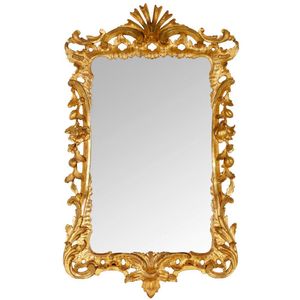
Ebonised & Gilt Pier Mirror in Thomas Hope Style by Barrow
An ebonised and gilt pier mirror in the manner of Thomas hope by Brian barrow, modern, with a palmette frieze, the bevelled plate in a pylon shaped surround decorated with rosettes, the base centred with a Nile crocodile. Height 217 cm, width 101 cm.…

Neoclassical Pier Mirror by Brian Barrow, Provenance Dr. McLaughlin
A neoclassical style pier mirror by Brian barrow, modern, the egg and dart cornice above a broad frieze painted with naked gladiators, the bevelled plate flanked by fluted pilasters. Height 243 cm, width 108 cm. Provenance: The Estate of the Hon. Dr John…

George III Giltwood Rocaille Pier Mirror
A George III giltwood pier mirror, the rectangular plate within a rocaille scroll carved frame with pendant fruit and flowers. Height 117 cm, width 70 cm. Provenance: Bonhams & Goodman Auctions, 2008. Private collection, Sydney.

Georgian Pier Mirror, 20th Century
Georgian style pier mirror, 20th century, tall rectangular plate with moulded rim, height 158 cm width 42 cm. Provenance: The Collection of Janet and Graeme Webb, Wollogorang, NSW

18th Century Rococo Style Carved Wood Pier Mirror
Attributed to Luke Lightfoot (English), George III carved wood pier mirror, 18th century, in the rococo style, the shaped rectangular beveled plate within a pierced white painted surround of scrolls, acanthus foliage and flowers, the lower part centred by…

18th Century Georgian Pier Mirror with Floral Ornamentation
Georgian pier mirror, 18th century, with three plates surmounted by an urn of flowers flanked by birds and ribbon tied floral swags, raised on cornucopia legs, height 160 cm width 72 cm. Provenance: The Collection of Janet and Graeme Webb, Wollogorang, NSW

Fluted Blackwood Pier Mirror in Federation Style
Pier mirror early 20th century blackwood with, fluted design in the Australian Federation classical style, height 150 cm, length 71 cm
 Loading more...
Loading more...